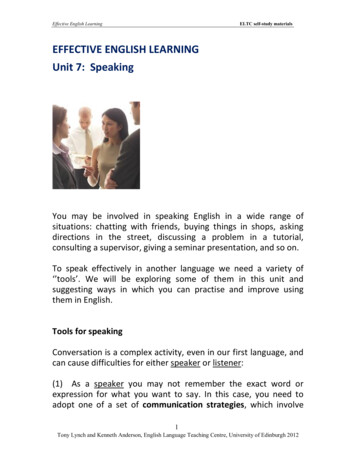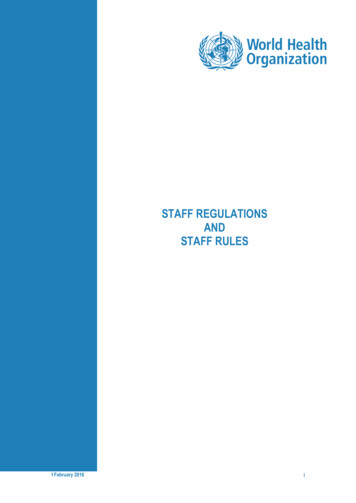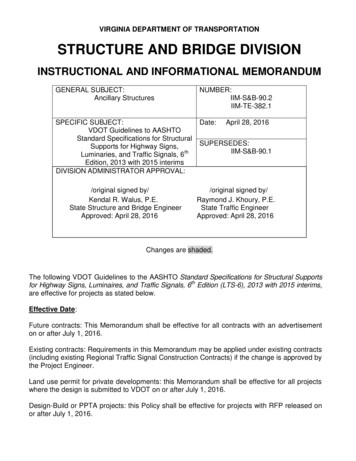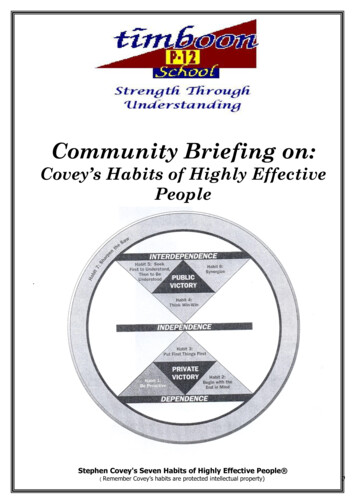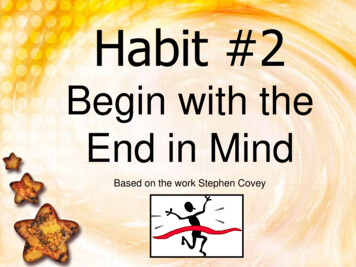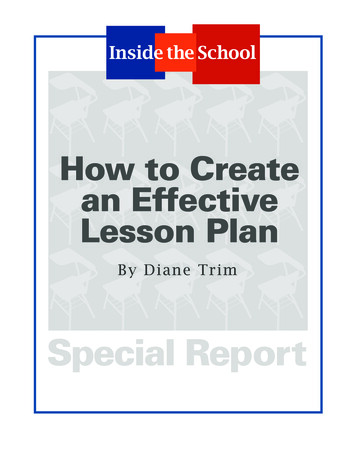
Transcription
How to Createan EffectiveLesson PlanBy D i a n e T r i mSpecial Report
TABLE OF CONTENTSTable of Contents . 1How to Create an Effective Lesson Plan . 2Step One: Assemble Materials. 4Step Two: Objectives. 5Step Three: Major Activities. 7Step Four: Content Mapping. 8Step Five: Calendar. 10Step Six: Unit and Lesson Planning . 12Step Seven: Send out Photocopies, Reserve Resources. 14Quick Start Guide to the Unit and Lesson Planning Tool . 15Unit Planner . 17Planning Calendar. 19Daily Lesson Planner . 21Unit Binder Cover Page . 24How to Create an Effective Lesson PlanInsideTheSchool.com1
HOW TO CREATE AN EFFECTIVEEFF ECTIVE LESSONPLANFor new teachers who are learning their craft and seasonedveterans who are implementing new curriculum, lesson planningcan be daunting. Teachers struggle to cover as much of thecurriculum as possible while also differentiating instruction to meetstudents’ learning styles and multiple intelligences.To be effective, learning needs to follow Bloom’s Taxonomy as wellas the latest brain research and learning styles. Teachers try tointegrate technology and have authentic assessments.That’s a lot to ask of a lesson plan.This free printable report is a practical guide. You’ll find an indepth, step-by-step method for creating your unit and daily lessonplans and provide you a planner to create a unit, unit calendar, anddaily lesson plans.The unit and lesson planning tool is categorized according to soundeducational theory: Bloom’s Taxonomy, Learning Styles,Standards-Based Learning, and Differentiated Instruction all makeup the basis for the unit and lesson planners.Effective planning for instruction is time-consuming and thoughtintensive. However, planning well up-front will pay off over time.You’ll be able to create a unit binder that you can use year afterHow to Create an Effective Lesson PlanInsideTheSchool.com2
year and adapt your lessons no matter how your curriculum ortextbooks change.How to Create an Effective Lesson PlanInsideTheSchool.com3
STEP ONE: ASSEMBLE MATERIALSM A T ER I AL S N E ED E D :Computer with a printerState and district standards (one set for each course)Textbooks and other materials for the unitPost-it notes to use as flags and remindersSchool calendar with holidays and major eventsRing binder dedicated to the unit and a three-hole punchA copy of the Unit Planner, pages 17 - 18A copy of the Planning Calendar, pages 19 - 20Several copies of the Daily Lesson Planner, pages 21 - 23A copy of the Unit Binder Cover Page, page 24Helpful but not essential: a flash drive to store tests, quizzes,handouts, and presentationsHelpful but not essential: a printer with photocopying andscanning abilitiesOrganize materials where you’ll do your planning. Just as you’dadvise students to have a dedicated area at home to do homework,have a dedicated area at school, home, or both for lesson planning.Keep the materials above handy in the lesson planning area.If you’re a teacher who shares a classroom or travels amongschools, keep a lesson planning kit in an oversized briefcase. Tote itfrom one room to another and still have your materials organized.It’s also wise to scour the school textbook room for preview copiesfor your teacher’s edition textbooks. If you can find one of these,keep it in your lesson planning area at home so you don’t have tohaul heavy books when you plan.If you haven’t downloaded the Word-friendly planning documentsthat accompanied this Free Report, visitwww.InsideTheSchool.com and download them from The FreeReports section.How to Create an Effective Lesson PlanInsideTheSchool.com4
STEP TWO: OBJECTIVESWhen you lesson plan, it’s best to begin with the end. In otherwords, ask yourself: what do I want the students to achieve? Develop a central concept or theme. Instead of naming yourunit “Chapter 22” or Animal Farm, label the unit with somethingthat’s linked to the theme of the unit. Shift away from thecontent, which will likely change when the district implementsnew textbooks, and stick with a theme that will outlast anychanges in content. For example, instead of naming a unitAnimal Farm, I might name it Satire instead. Choosing Satireover the book title allows me to switch books and teachGulliver’s Travels instead. Some of the lesson plan will changeaccording to the content; however, much of the work willremain the same.Discover the why. Students, like many adults, are practicalsouls. They want to know why they’re learning the quadraticequation. Will it help them buy a car or refinance a home? Comeup with a connection for the unit before you plan anything else.Prepare to mine your own connections with the content so youcan spark an interest for your students. Career opportunities,life skills applications, social interactions, sports, and money areall good places to find student interest that aligns with yourcontent or concept. Write down your connection next to yourconcept and try to play to the connection as much as possiblewhen planning activities.Develop your learning goals. What do you want your studentsto learn to prepare them for the next level of study in yourdiscipline? What should they know if they want to go tocollege? What should they know if they want to use theinformation in life? The answers to these questions willprobably all be different, but they’re a great first step to writingobjectives.Use the state standards as a guide. Have a copy of your state’sand district’s objectives or standards handy for lesson planning.If you teach more than one course, make copies of the relevantHow to Create an Effective Lesson PlanInsideTheSchool.com5
HELPFUL VERBSstandards for each course. When you select state standards totarget for your unit, write an abbreviation for the unit next tothe standard. Keeping track in this simple way will ensure thatyou cover all the state and district objectives for your discipline.Write the objectives. With your learning goals and the statestandards side-by-side, you can develop objectives for yourunit. Objectives should be written either beginning with,“Students will learn to ” or with just the verb “Observe achemical reaction and note observations in a lab journal.”Remember to keep your objectives specific and measureablebecause you’ll want to assess students over these objectives.FORWRITING OBJECTIVESI keep a list of verbs in my lesson planning kit. Print this off andyou’ll have one, teDescribeHow to Create an Effective Lesson Write6
STEP THREE: MAJOR ACTIVITIESWhile looking at the objectives I’ve selected, I list those in the UnitPlanner, page 17, column under objectives. I try to slot them intothe correct row according to Bloom’s Taxonomy, which you’ll seeon the right of the table. If you’re not familiar with Bloom’sTaxonomy, the table has a referencer on the left. You’ll find a briefexplanation of his work on page 12 of this report.The Activities column is tied to the Assessment column so you’llremember to assess students throughout the unit. Tying togetheryour objectives, activities, and assessment at the planning stateensures that your students will achieve the objectives and notspend time on activities they don’t need.The unit planner is available on InsideTheSchool.com in thePrintables section as a Word-compatible document. Feel free to addrows, delete unused objectives and assessments, and expandcolumns to make it work for you.How to Create an Effective Lesson PlanInsideTheSchool.com7
STEP FOUR: CONTENT MAPPINGWe live in an information age where content comes in traditionalformats like books, workbooks, and videos as well as digitalformats like CDs, the Internet, and electronic documents.Our students are digital natives. They carry iPods, cell phones, andflash drives. When not in class they IM, e-mail, and text messageone another while playing video games or surfing the ‘Net.The challenge in the information age is to sort through themessages and separate the valid and credible from the noise. It’sthe teachers’ job to sort through the information and offer studentssources of content that come from both traditional and digitalsources. Books are still valid, but are often out of date at the time ofprinting. Articles, Web pages, and digital texts are good sources ofreal world content that are both relevant and speak to the students’need for current information. Gather materials. When planning a unit, gather the classroomtextbooks and materials. Conduct an Internet search for crediblecurrent sources. Find realia (articles or objects from the realworld), video, or audio to use in your unit. Choose sources thatwill appeal to your digital natives.Mind map. Just as you’d recommend mind mapping orwebbing ideas to your students, do the same with your content.In the center of your map, place your concept. Around the mindmap, place your learning objectives. Off of the learningobjectives, map your content.Connect your content to your objectives right away to ensurethat all content is important. Often teachers will keep content oran activity that they’ve always done with students, but whichdoesn’t match up to a learning objective. A good example of thismismatch between content and objectives is an activity wherestudents build a replica of the Globe Theater for a unit aboutone of Shakespeare’s works. Building the theater out of PopsicleHow to Create an Effective Lesson PlanInsideTheSchool.com8
sticks might seem interesting and engaging; however, it doesn’tinvolve reading, writing, speaking, or listening and is unlikelyto align with state standards for English/Language Arts.Content Mind MappingHow to Create an Effective Lesson PlanInsideTheSchool.com9
STEP FIVE: CALENDARIt’s a wise idea to create a calendar for each unit, and indeed, theentire school year. Teachers who plan well find plenty of time atthe end of the semester to finish grading papers and for students toreview before exams. Teachers who don’t plan well need to cramcontent into the last two weeks before the end of the semester orrisk sending students to the next course with too few skills to besuccessful.Having a unit calendar also makes it easy for you to plan yourwork load. You can schedule a batch of research papers to arrive onyour desk just before winter break so you can pace yourself overthe holiday with four or five papers to grade per day, not 20.Students can plan better, too. When you give your class thecalendar with objectives, activities, assignments, and assessmentson it, students can work ahead if they know they have a sportingevent or social activity. If a student is absent, she can check the unitcalendar and stay on track.Special education teachers will thank you for your unit calendarwhen you give them a copy. They can assist students to turn inmissing work and adapt lessons for their students’ needs. Look at your scope and sequence. Before you fill out thecalendar on page 19, look at your curriculum and scope forthe year. How many units do you have to teach? How manydays can you allow for each unit? Write the number of daysin your curriculum guide next to each unit.Find the district calendar. Locate the school calendar inyour lesson planning kit. Find the month that you’ll beteaching the unit and block off the days in pencil that you’llneed for teaching. Take special note of national, religious,and school holidays or special events. It’s unwise to plan aunit final test for the same day as the Homecoming game.How to Create an Effective Lesson PlanInsideTheSchool.com10
Likewise, avoid ending units on days when a majority of theclass will take standardized tests.Print a working calendar. Or two. Turn to page 19, ordownload the Word document file that accompanied thisreport from www.InsideTheSchool.com Mark off the daysthat you have available to teach the unit. Add rows or deletethem from the document as you need them.Neatness doesn’t count. It’s smart to have a few copies ofthe calendar on hand – it’s a working document and youshould feel free to scribble and erase without worry. Thecalendar uses abbreviations: T topic, O objective, A activity, and AA assessment. Feel free to abbreviate asmuch as you need to on the working copy of the calendar.Begin with the end. Outline the last day of your unit with ahighlighter. Do you plan to end with a final test or project?Enter that test or project in the highlighted square next toAA (assessment).Work backwards. Working from the end date, fill in theother important dates and benchmarks in the unit. Wait tofill in the activities and minor assessments until you’vefinished completing the Unit Planner Tool.How to Create an Effective Lesson PlanInsideTheSchool.com11
STEP SIX: UNIT AND LESSON PLANNINGOn page 17 of this free report or in the downloadable Worddocuments that accompany this report online atwww.InsideTheSchool.com, you’ll find the Unit Planner. ThePlanner takes all the information from Step Four’s Content Mapand fits it into Bloom’s Taxonomy, a hierarchy of learning.Educational psychologist Benjamin Bloom and his colleaguescreated a taxonomy of knowledge in the 1950’s, and his researchand theories are commonplace in education.Bloom created categories for knowledge and ordered them in ahierarchy from the simplest learning tasks to the most complex,from the most concrete ideas to the most abstract. For moreinformation on Bloom’s Taxonomy, see:Krathwohl, D.R. (2002.) A Revision of Bloom’s Taxonomy:An Overview. Theory into Practice. The Ohio State University,211-218. Sort your mind map. Arrange your objectives from yourmind map into the Taxonomy, making sure that you haveobjectives at every level of the hierarchy. If you have gaps,go back to your mind map and revise both your objectivesand content to make sure that your students have both astrong knowledge base and opportunities to participate inhigher-level thinking. Fill in the Unit Planner. Place check marks in appropriateboxes, insert objectives, and fill in just the barest sketches foractivities. You’ll flesh these out in the Daily Lesson Planner,page 21, complete with matching them up to learning styles. Fill in the Daily Lesson Planner. You’ll need a copy of theDaily Lesson Planner for each day of your unit. Here’swhere we get specific and flesh out the activities andHow to Create an Effective Lesson PlanInsideTheSchool.com12
objectives. Include an estimate of how much time eachactivity will take and match activities up to learning styles,multiple intelligences, and assessments. If you haven’t doneso already, download the planning files fromwww.InsideTheSchool.com. You’ll find the files as Wordfriendly documents that accompanied this Free Report. Check your work. Make sure each activity has some sort ofassessment, whether it’s formal (test, quiz, or assignment) orinformal (check for understanding). Double-check thatyou’re addressing many learning styles and multipleintelligences.How to Create an Effective Lesson PlanInsideTheSchool.com13
STEP SEVEN: SEND OUT PHOTOCOPIES, RESERVERESOURCES Gather master pages for photocopying. It’s useful to gatherall pages for photocopying into packets to distribute tostudents at the beginning of each unit. Include a unitcalendar in the packet, too. Distributing packets reduces theamount of time you’ll spend passing out paper during classand helps students who are absent or in extra-curricularactivities catch up on class work.Organize materials and resources. Once you’ve made yourplans, transfer the materials you need from your individualDaily Lesson Planner sheets to the Binder Cover Sheet(pages 21-24). Note on the Binder Cover Sheet the resourcesyou’ll need to reserve for the unit. (To receive these pages asa downloadable Word document, go to the Free Reportspage at www.InsideTheSchool.com and choose How toCreate an Effective Lesson Plan.)Use color, when possible. Try color-coding your units: redfor those in the beginning of the year, violet for those at theend. Use a color cover sheet for handout packets and colorfor your tests or quizzes. It makes grading easier, especiallywhen tests or quizzes come in late. You can easily match upphotocopies to the correct unit binder without much time orenergy.How to Create an Effective Lesson PlanInsideTheSchool.com14
Quick Start Guide to the Unit and Lesson PlanningToolO R G AN I Z I N GTH EU N I T B I N D ERWhen I plan lessons, I stack the sheets I’ll need to photocopy as Iwrite out the individual plans. I gather these pages into two stacks:assessment and handouts. Include your rubrics in the handoutstack. I keep each stack in clear plastic ring binder sleeves. When itcomes time to photocopy, I send the whole batch to our district’scopying service at once.From the handouts stack, I create a packet to give students at thebeginning of the unit. It’s easier to hand out a big batch of papersonce every three weeks than to pass out papers individually everyday. The copying service punches them to fit in three-ring binders,so students have an easier time keeping track of the handouts aswell. I make five extra classroom packets and one for myself that Ican mark up with notes from class discussions. It’s useful toinclude a unit calendar in the packet, too. When a student is absentshe can refer to the calendar and know what classroom activitiesshe’s missing.When organizing a unit binder, I put the Cover Page, Unit Plannerand Planning Calendar on top (pages 17-20), followed by the plasticprotectors full of master copies. The individual Lesson Plannersheets (pages 21-23) for each day should go next. It’s wise to haveall the answer keys together at the back of the binder. I don’trecommend putting the keys together with the individual lessonplans; some students have make-up quizzes or tests and it’s easierto have them all at the back of the binder.When you re-use the binder for the next year, be sure to look atyour notes on the bottom of the individual lesson plan sheets. Makenecessary changes to handouts, tests, and lesson plans beforesending the work off to the copying service.How to Create an Effective Lesson PlanInsideTheSchool.com15
HOWTOUSETH I SPLANNING TOOLThis is a flexible tool that you can put on your hard drive and useas a template for multiple units. Download these planning pages asWord documents in the Free Reports section ofwww.InsideTheSchool.com. Copy the Daily Lesson Planner pages at the end of this freereport. You’ll need one daily lesson plan, pages 21 – 23, foreach day of your unit. Delete unnecessary tick boxes. If you’re planning at yourcomputer, feel free to delete rows or choices you don’t use.There’s no need to keep empty options for assessment orobjectives on your plan. Appeal to learning styles and multiple intelligences. Try tooffer your students a variety of teaching activities thatappeal to the various learning styles and multipleintelligences and select different options for assessment aswell. The brain loves novelty. Try not to repeat activities toooften over the course of the unit.How to Create an Effective Lesson PlanInsideTheSchool.com16
UNIT PLANNERThis tool is a big picture worksheet. You’ll list what concepts you want to teach, whatobjectives, and what activitiesCurriculum to cover (list readings, concepts, skills that students will learn):Bloom’staxonomy levelKnowledgeRecalls data orinformationComprehensionUnderstands theinformation and putsit into her own wordsAnalysisSeparate informationinto parts tounderstand itsstructureVerbs forobjectivesObjectivesActivitiesAssessment Defines Describes Identifies Reorganizes Matches Labels Lists Reproduces Names Outlines Recalls Selects Converts Defends Computes Constructs Demonstrates Manipulates Modifies Predicts Prepares Solves Differentiates Paraphrases Observation Journal entry Mind map Exit slip Essay Diagram Objectivequestions Discussion Simulation Analyzes Compares Contrasts Diagrams Identifies Outlines Experiments Debates Measures Developsrubrics Researches Observation Field work Lab work Essay Diagram Demonstration Interview Exit slipHow to Create an Effective Lesson PlanInsideTheSchool.com Observation Journal entry Mind map Exit slip Essay Diagram Objectivequestions Discussion Simulation17
SynthesisCreates a newproduct from theinformationEvaluation Categorizes Combines Develops Organizes Generates Plans Revises Rewrites Appraises Compares Critiques Judges Evaluates Justifies SupportsHow to Create an Effective Lesson PlanInsideTheSchool.com Observation Debate Presentation Publication Product, model Exit slip Observation Debate Presentation Publication Product Exit slip18
PLANNING CALENDARHere’s where you’ll match up the objectives from the above chart to the actual days youhave to teach the unit. Write in the date above each big rectangle. Make note of anyspecial days (Homecoming, day before a holiday, major testing days). Fill in the bigevents first: the beginning of your unit, the culminating activity, and where the objectivetest should go. From there, fill in the smaller activities. T stands for topic, O stands forobjective, A stands for activity, and AA stands for assessment.MondayDay 1TuesdayDay 2WednesdayDay 3ThursdayDay 4FridayDay 5T:T:T:T:T:O:O:O:O:O:A:A:A:A:A:AA:AA:AA:AA:AA:Day 6Day 7Day 8Day 9Day 10T:T:T:T:T:O:O:O:O:O:A:A:A:A:A:AA:AA:AA:AA:AA:Day 11Day 12Day 13Day 14Day 15T:T:T:T:T:O:O:O:O:O:A:A:A:A:A:AA:AA:AA:AA:AA:How to Create an Effective Lesson PlanInsideTheSchool.com19
Day 16Day 17Day 18Day 19Day 20T:T:T:T:T:O:O:O:O:O:A:A:A:A:A:AA:AA:AA:AA:AA:How to Create an Effective Lesson PlanInsideTheSchool.com20
DAILY LESSON PLANNERFrom the Planning Calendar, insert the day # at the top left as well as the unit and day’stopic. Strive to insert a time for each activity and check off some kind of assessment (youcan add or remove parts from the list as needed). Describe in detail the activities. Youmight be handing this plan off to a substitute teacher or using it next year. Do the workonce and be grateful you’ve finished it! Feel free to erase this text as well as the examplein the first row. It’s a good idea to highlight any technology that you’ll have to reserve inadvance in yellow so you’ll remember to reserve it.Opening – connects the lesson with student prior tipleintelligencesAssessmentMaterialsStudents willconnect theirprevious experienceswith motion with theacceleration andvelocity.Students develop lists of transportation ingroups. As a class, we list alltransportation on the board and then sorttransportation from fastest to slowest,from fast acceleration to slow acceleration. Auditory Interpersonal Observation Discussionnone Visual Auditory Kinesthetic Observation Journalentry Mind map Exit slip Essay Diagram Objectivequestions Discussion SimulationTechnologyExample00:00 Linguistic Logical Spatial Musical Interpersonal Intrapersonal NaturalisticTeaching activities – gives students knowledge base for learning activities Visual Auditory Kinesthetic Linguistic Logical Spatial Musical Interpersonal Intrapersonal Naturalistic Visual Auditory Kinesthetic Linguistic Logical Spatial Musical Interpersonal Intrapersonal NaturalisticHow to Create an Effective Lesson PlanInsideTheSchool.com Observation Journalentry Mind map Objectivequestions Discussion Exit slip Observation Journalentry Mind map Objectivequestions Discussion Exit slip21
Learning activities – gives students opportunities to practice and explore Visual Auditory Kinesthetic Linguistic Logical Spatial Musical Interpersonal Intrapersonal Naturalistic Visual Auditory Kinesthetic Linguistic Logical Spatial Musical Interpersonal Intrapersonal Naturalistic Observation Journalentry Discussion Simulation Field work Lab work Essay Diagram Demonstration Interview Exit slip Debate Presentation Publication Product,model Observation Journalentry Discussion Simulation Field work Lab work Essay Diagram Demonstration Interview Exit slip Debate Presentation Publication Product,modelClosure – offers students reflection and extension opportunities Visual Auditory Kinesthetic Linguistic Logical Spatial Musical Interpersonal Intrapersonal Naturalistic Observation Journalentry Exit slipHomework Visual Auditory Kinesthetic Linguistic Logical Spatial Musical Interpersonal Intrapersonal NaturalisticHow to Create an Effective Lesson PlanInsideTheSchool.com22
Post-lesson Reflection:How did it go?1234TerribleNot GreatO.K.Pretty Well5Fabulous!What worked?What didn’t work?Changes for next time:How to Create an Effective Lesson PlanInsideTheSchool.com23
UNIT BINDER COVER PAGEUse this cover page as the first page in your unit binder. Record the unit’s concept hereas well as whatever resources and materials you’ll need to reserve or gather before theunit begins.It’s also a good place to record your reflections about the unit. Each time you finishteaching the unit, put the binder back in order and jot a quick note to yourself aboutchanges you’ll need to make for next time.Unit ConceptMaterials NeededChanges for Next Time:Date or YearChange neededHow to Create an Effective Lesson PlanInsideTheSchool.comResources to Reserve in AdvanceDone?24
Prepare to mine your own connections with the content so you can spark an interest for your students. Career opportunities, life skills applications, social interactions, sports, and money are all good places to find student interest that aligns with your content or concept. Write down





